Excerpts from Jim Conrad's
Naturalist Newsletter
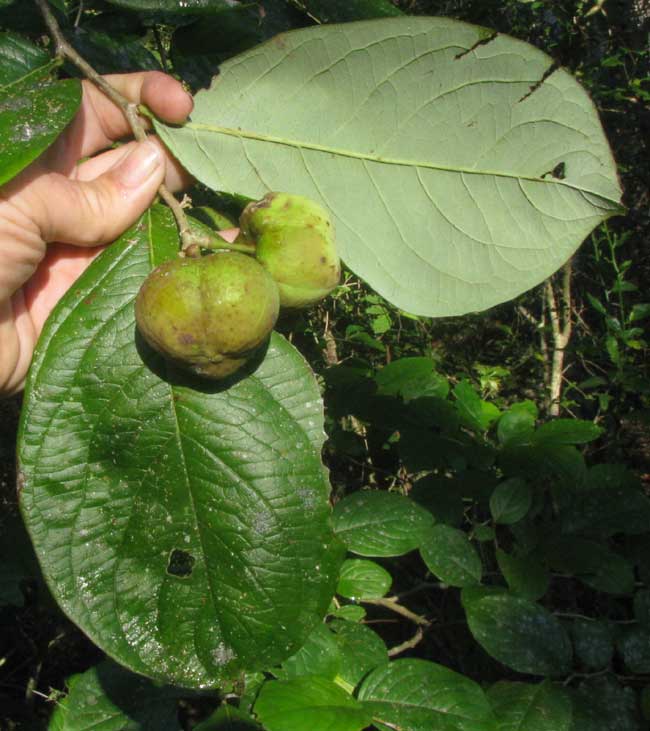
from the January 29, 2012 Newsletter issued from Hacienda Chichen Resort beside Chichén Itzá Ruins; limestone bedrock; elevation ~39m (~128ft), N20.675°, W88.569°; central Yucatán state, MÉXICO
THE GARCIA TREE
After over two years of being here, not over a hundred yards (meters) from the hut, a tree species has turned up that's new to me, an exciting discovery. It's about 12 feet tall (3.7m) and is fruiting. You can see the tree's three-parted, drupe-type fruits and broad leaves that are much lighter below than above at the top of this page.
A fruit displaying its thin, dry and fairly hard husk is shown below:
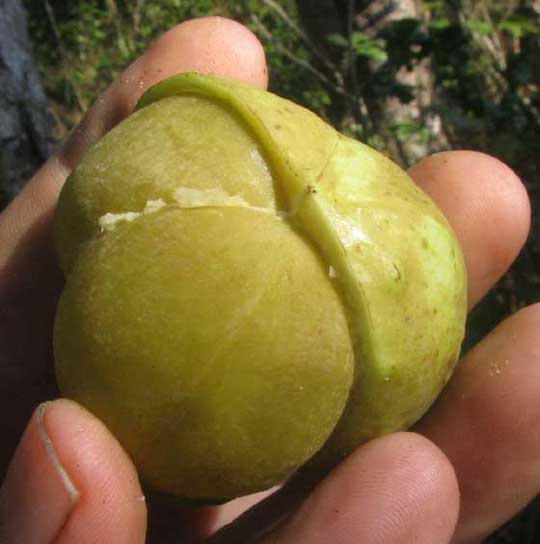
The brittle, dry drupe is divided into three hollow compartments, or carpels. In each carpel two dry seeds hang suspended in otherwise empty chambers as shown below:
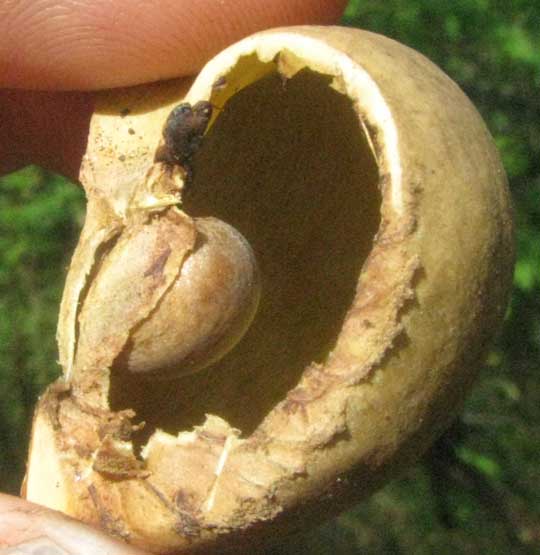
Three lobed fruit suggested that the tree belonged to the Spurge or Poinsettia Family, the Euphorbiaceae. On the Internet when I searched for Mexican tree species in that family, the leaves and unusual fruits matched those of GARCIA NUTANS, a little known tree seldom noted, but found from the central and southern lowlands of Mexico and the Caribbean islands south to Columbia in northern South America.
I can find no English name for the plant except False Tungoiltree, and I just don't like that name, and will call it Garcia here.
What a buzz to find something so rare and interesting -- and so close to my own front door!
entry from field notes dated October 7, 2022, taken about 3kms north of Gómez Farías, on the lower eastern slope of the Eastern Sierra Madres, El Cielo Biosphere Reserve, southern Tamaulipas state, MÉXICO; elevation about 300m (1000 ft), ± LAT. 23.04°N, LONG. -99.15°W
GARCIA IN NORTHEASTERN MEXICO
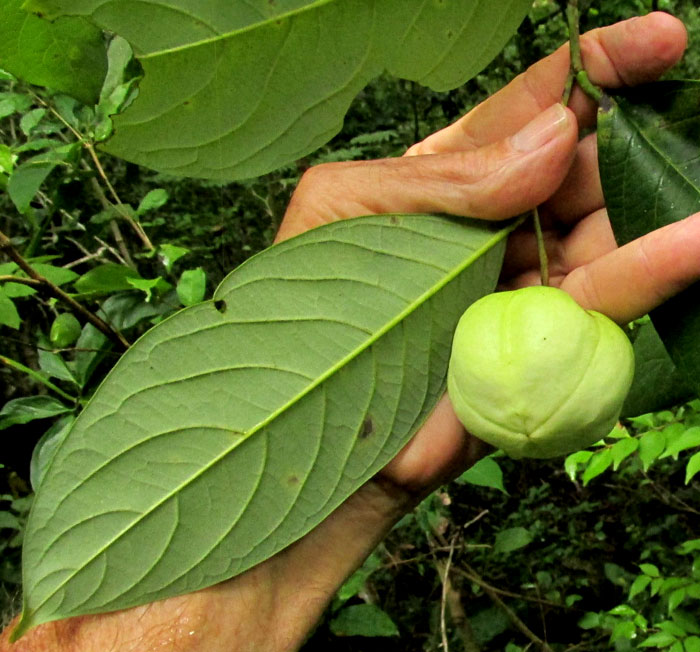
Along the steeply inclined, deeply rutted gravel road approaching the bottom of Cañón el Azteca, Aztec Canyon, about 3 kms north of the village of Gómez Farías, the above fruit at the tip of a branch of a 7m-tall tree (25ft) leaning from the forest edge surprised me. The previous entry from 2012 in the Yucatán shows that we've seen this species before, and regarded it as "a little known tree seldom noted, but found from the central and southern lowlands of Mexico and the Caribbean islands south to Columbia in northern South America." Here we're not in southern Mexico, but rather what's regarded as the northeast.
Previously no indication of the leaves lack of hairs was given, so here's the hairless or nearly hairless undersurface of an aged leaf:
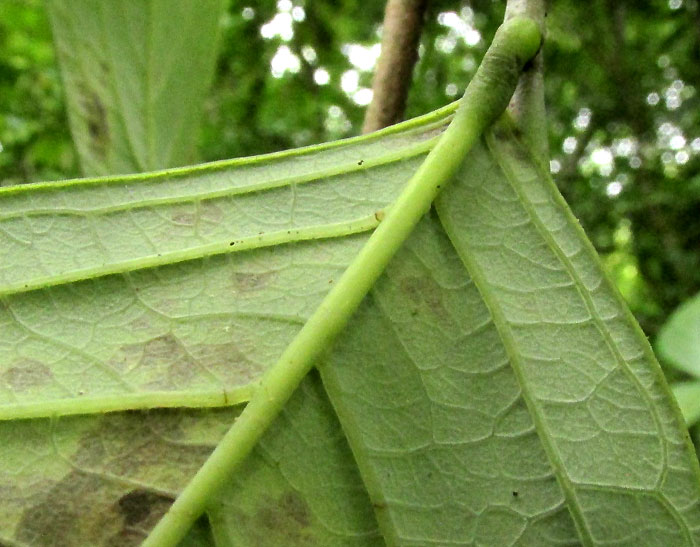
During the last ten years much more information about species has become available on the Internet. For example, now gbif.org provides an excellent map showing locations where Garcia nutans has been documented.
Mark Westgate, back when vegetable oils were used to make varnish, in his 1944 paper "Chemical and Botanical Studies on Newer Hard Drying Vegetable Oils," wrote that "Confirmation is obtained for an earlier report that Garcia nutans oil is superior to American tung oil as a varnish oil. Explorations in Mexico and Central America reveal few Garcia nutans trees."
Oil from Garcia nutans is derived from the seeds. The seed photographed earlier in the Yucatan was fairly small, and took up only a small part of the fruit's chamber, so I began wondering if maybe the seed had been aborted before it could fill the chamber. In J. Theodore Cash's 1908 publication "On the Physiological Action of the Seeds of Garcia nutans, Omphalea megacarpa and Omphalea triandra from Trinidad," I read that the average length of 15 seeds he examined was 16mm.
Referring to the image atop this page, on my computer screen the larger fruit measures about 22mm long, while my thumb, on the screen, measured at the thumbnail's base, is about 13mm across. In real life my thumb measured the same way is 20mm across. Using ratio and proportion, this means that the fruit in our picture was about 34mm long. In our second picture showing the seed in its chamber, the fruit on my screen measures about 75mm, a few mm added because the fruit is held diagonally. The seed on the screen is about 45mm long. Accepting that the real fruit was 34mm long, more ratio and proportion gives the real length of the seed in our picture as 20mm, compared to 16mm of the Trinidad plants. Despite the discrepancy, the numbers seem to suggest that the seed in our above picture isn't stunted, and that the seeds naturally occupy oversized chambers.
In 1908 Theodore Cash clearly thought he had something rare and exotic when someone sent him some Garcia nutans seeds, even nibbling on them to see what would happen. He found that the seed's odor was nut-like and agreeable, but that on chewing some he found that "...soon an unpleasant tickling or scratching manifests itself chiefly in the velar and pharyngeal regions." He even convinced a local person to eat six grams of fresh seed, after which 2½ hours later the man felt "Some gastric discomfort soon succeeded by borborygmi." Borborygmus, I find, is "a rumbling or gurgling noise made by the movement of fluid and gas in the intestines." Five hours, 20 minutes later there was "One alvine evacuation {he pooped} with discomfort," and nine hours later there was a "second evacuation of similar character," with no further disturbance during the night. Cash goes on for pages like this with further similar experiments.
The CABI Digital Library reports that in Colombia Garcia nutans has been used medicinally as a purgative, "... with a single seed said to be sufficient to induce vomiting."